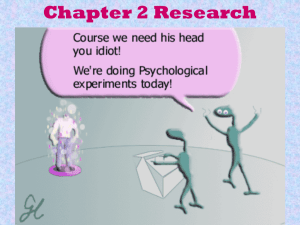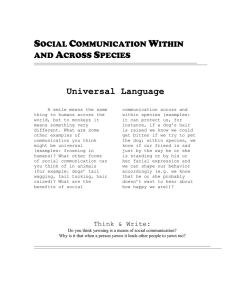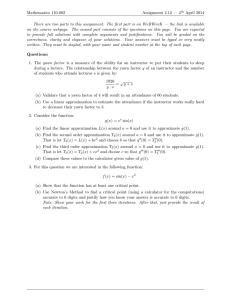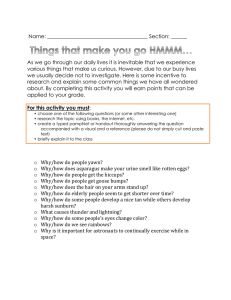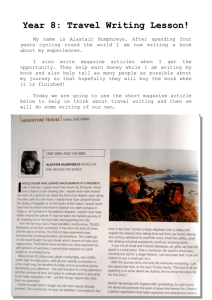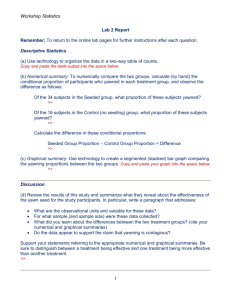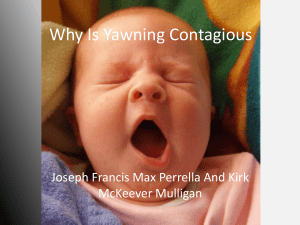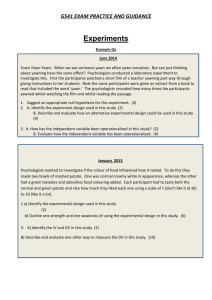Is yawning contagious?
advertisement
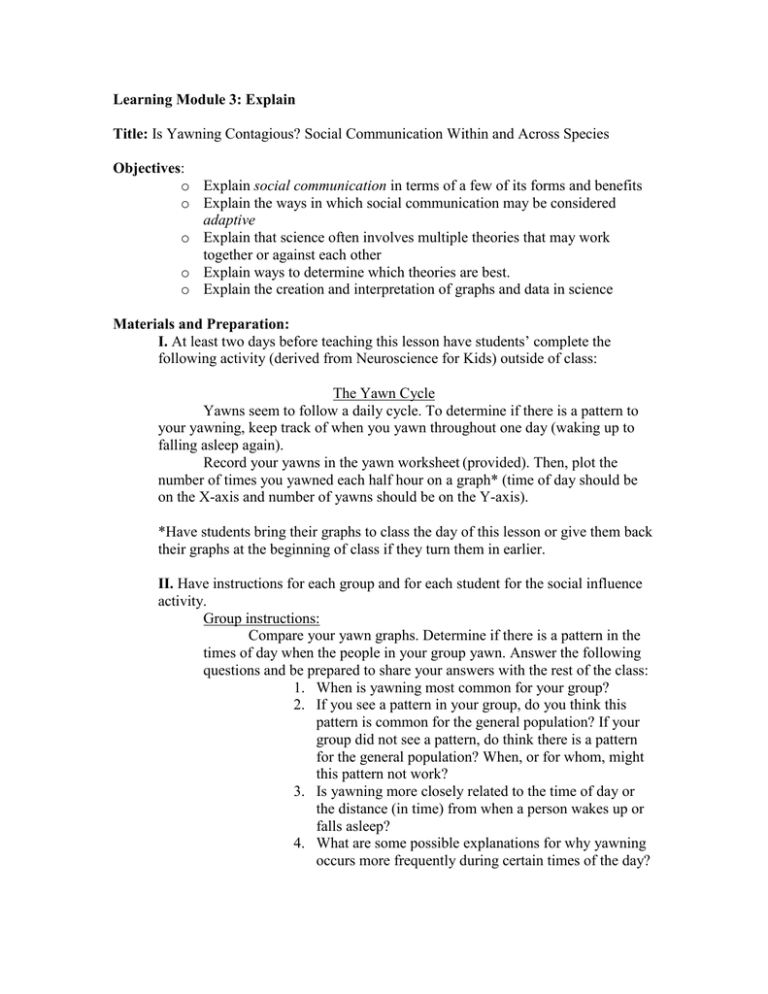
Learning Module 3: Explain Title: Is Yawning Contagious? Social Communication Within and Across Species Objectives: o Explain social communication in terms of a few of its forms and benefits o Explain the ways in which social communication may be considered adaptive o Explain that science often involves multiple theories that may work together or against each other o Explain ways to determine which theories are best. o Explain the creation and interpretation of graphs and data in science Materials and Preparation: I. At least two days before teaching this lesson have students’ complete the following activity (derived from Neuroscience for Kids) outside of class: The Yawn Cycle Yawns seem to follow a daily cycle. To determine if there is a pattern to your yawning, keep track of when you yawn throughout one day (waking up to falling asleep again). Record your yawns in the yawn worksheet (provided). Then, plot the number of times you yawned each half hour on a graph* (time of day should be on the X-axis and number of yawns should be on the Y-axis). *Have students bring their graphs to class the day of this lesson or give them back their graphs at the beginning of class if they turn them in earlier. II. Have instructions for each group and for each student for the social influence activity. Group instructions: Compare your yawn graphs. Determine if there is a pattern in the times of day when the people in your group yawn. Answer the following questions and be prepared to share your answers with the rest of the class: 1. When is yawning most common for your group? 2. If you see a pattern in your group, do you think this pattern is common for the general population? If your group did not see a pattern, do think there is a pattern for the general population? When, or for whom, might this pattern not work? 3. Is yawning more closely related to the time of day or the distance (in time) from when a person wakes up or falls asleep? 4. What are some possible explanations for why yawning occurs more frequently during certain times of the day? Individual instructions: One student in each group should receive instructions that include at the end a “secret” note: “Do not let your group members know what you are doing, but yawn/smile/laugh in order to get your group members to yawn/smile/laugh also. Using the classroom clock, time how long it takes to get each member of your group to yawn/smile/laugh. Be prepared to share your findings with the class.” Background Information: Terms: adaptation – an organism’s changes in order to be better suited for their environment vestigial response – an evolved response that is “leftover” pandiculation – the act of stretching and yawning surfactant – oil-like substance that helps keep lungs lubricated inside and keeps them from collapsing Resources: How stuff works “What makes us yawn?” http://www.howstuffworks.com/questions572.htm KidsHealth “Why do I yawn?” http://www.kidshealth.org Little Mystery: Why do we yawn? http://msnbc.msn.com/id/3076713 Neuroscience for kids http://faculty.washington.edu/~ chudler/clock.html http://faculty.washington.edu/~chudler/yawning.html NewScientist.com “Yawning is catching in chimps” http://www.newscientist.com/article.ns?id=dn6182 Activities: Attention Getter Universal Language A smile means the same thing to humans across the world, but to monkeys it means something very different. What are some other examples of communication you think might be universal (examples: frowning in humans)? What other forms of social communication can you think of in animals (for example: dogs’ tail wagging, tail tucking, hair raised)? What are the benefits of social communication across and within species (examples: it can protect us, for instance, if a dog’s hair is raised we know we could get bitten if we try to pet the dog; within species, we know if our friend is sad jus by the way he or she is standing or by his or her facial expression and we can shape our behavior accordingly (e.g. we know that he or she probably doesn’t want to hear about how happy we are))? Think & Write: Do you think yawning is a means of social communication? Why is it that when a person yawns it leads other people to yawn too? Several Sides I. Discuss the students’ ideas about yawning. II. Share the following facts about yawning: 1. On average, yawns are six seconds long. 2. Humans first yawn 11 weeks after conception (That’s before they are born! And fetuses do not take in oxygen through their lungs.) 3. Between one and two years of age, yawns become contagious to humans. This is the same age when humans begin to recognize themselves in the mirror. 4. During a yawn, heart rate can increase up to 30 percent. 5. 55 percent of people will yawn within five minutes of seeing someone else yawn. 6. Blind people yawn more after hearing an audiotape of people yawning. 7. Reading about yawning will make you yawn. 8. Olympic athletes often yawn before competition. 9. Some birds, reptiles, and even fish yawn. Most mammals also yawn. III. Share the following details or ideas taken from experiments conducted on yawning: 1. Neurotransmitters (such as dopamine, excitatory amino acids, nitric oxide) and neuropeptides increase yawning if injected into the hypothalamus of animals. 2. Yawning is a social cue for everyone in a group to sleep at the same time 3. “Our data [from a study of chimps] suggest that contagious yawning is a byproduct of the ability to conceive of yourself and to use your experience to make inferences about comparable experiences and mental states in others.” --Gordon Gallup, an evolutionary psychologist at the State University of New York in Albany 4. When a yawn occurs, teeth are exposed. This may be interpreted as intimidating and result in “contagious” yawns. 5. 17-19 year old students who watched music videos yawn less (3.41 yawns in 30 minutes) than students who watched a color test bar pattern (5.78 yawns in 30 minutes). --Dr. Provine, psychologist at the University of Maryland, Baltimore County (a leading expert on yawning) 6. Dr. Provine also found that breathing just carbon dioxide (and exercise, for that matter) causes faster breathing, but dos not result in an increased number of yawns. 7. Yawning and breathing are controlled by different mechanisms. 8. A closed mouth yawn feels “unsatisfying.” –Dr. Provine 9. Yawning is a protective reflex to redistribute surfactant that helps lubricate lungs and keeps them from collapsing. 10. The brain prompts a yawn to get more air into the lungs, because if the air sacs in the lungs do not get fresh air, they partially collapse and the lungs stiffen a bit. -Dr. Barry Make, a pulmonologist at National Jewish Medical and Research Center in Denver 11. Humans may have used yawns at one time to indicate a change in social activity. IV. Present different theories about why people yawn. 1. The Stretching TheoryYawning stretches the lungs and lung tissue. Stretching and yawning may be a way to flex muscles and joints, increase heart rate, and feel more awake. 2. The Physiological TheoryYawning is an effort to draw in more oxygen or remove a build up of carbon dioxide in the lungs. 3. The Evolution TheoryYawning developed from early man for adaptive reasons 4. The Boredom TheoryThe dictionary definition of yawning says yawns occur a result of boredom or fatigue. V. Have students (individually, in groups, or as a class) match points from the list of facts and the list of experiments to the four main theories. The points can either support or provide evidence against the theory. VI. Discuss how these theories support the idea of adaptation. For example, all of the theories suggest that there is some reason that is beneficial to our survival for why we yawn, whether it is health related or simply helps indicate our feelings to others. Now that the students know what adaptation is, allow them to expand on this idea. Testing Theories Social Influence Activity Have students form groups and give each student an instruction and questions sheet (see materials). All but one group member will receive the same instructions. One group member will receive a secret instruction to yawn, smile, or laugh, and be told to time how long it takes his or her group to mimic what he or she is doing. The group will be given a task related to the yawn cycle assignment to complete in a given time while one group member attempts to get his or her entire group to do what he or she is doing without verbally expressing his or her instructions. As a class, discussion will address the activity, then go over answers to the yawning cycle questions if time allows. Each group should present its findings. ASK: Would there be a difference in how long it takes to lead someone to smile versus how long it takes to lead someone to laugh, and why? Think & Write: Based on the findings from the yawn cycle and social influence activities, which theory or theories do you think explain your findings? Reflection Think & Write: Where should research go now? Just because the experiments we conducted in class seemed to support specific theories, how could an experiment be designed to test other theories?
